 Lord Shiva and his wife Parvati The Ancient Turkish-Hindu "Spiritual" Solution to War and Collective Discord. What is a valid spiritual solution to wars, collective discords, and evil in general? Scriptures, singing, preaching, conversion tactics, bible-thumping, speculation, visions of white doves, idealistic political activism, lathering our enemies' faces with dirty, germ-laden kisses, turning the other cheek, throat-bursting hallelujahs, and other bizarre behaviors may not be spiritual at all, but ineffective and potentially destructive gropings in a world getting darker by the minute. If each human's real self is an eternal and subtle entity or spirit encased in a large piece of animated clay, and if this self actually exists, there must be a scientifically applicable and measurable technology for people to reconnect with it. It is not generally well-known that the ancient Turks and Hindus had basically two solutions for ending wickedness and evil in mankind's heart, called Manu or Manusa, and the other, known as Krsti (pronounced as Kristi), Kristaya, Kristihan, Kristhanu, and the like. (Reference: The Sanskrit Lexicon.) In Sanskrit, Manu= "The secondary God or Creator; man; mankind; Noah; thinking; wise; intelligent; representative man and father of the human race; the first to have instituted sacrifice and ceremonies; progenitor of the present races of human beings, etc."
According to Sanatana Dharma (The Holy Science of Human Spirituality and Behavior), the real name of Hinduism, mankind must reincarnate over and over again, many thousands of times, until he obtains the mentality, behavior, and spiritual qualities enabling him to broaden his domain and become himself a demi-god. Because Manu is eternally involved in the work of becoming a demi-god, using only his limited understanding and guesswork, his self-awareness or ego dulls his awareness of the Creator or God. For Christians, Manusa would represent Christ nailed to the horizontal beam of the Cross, completely separated from the vertical beam. As the Second God or Creator, Manu or Manusa is more commonly known as Baleva, "God of Confusion," better known in English as the words "belief" and "believe." Belief derives from the name of an ancient Turkic-Hindu God called Bali, Baliu, and Bel. In Sumeria, God Bel was depicted as a man with a bull's head and horns. Until Bel evolves to a genuine God, he can offer mankind only blood, tribulations, and unending tragedy on earth. That is why Bel was commonly called "Lord Second." (See The World's Sixteen Crucified Saviors, by Kersey Graves, p. 128.) Bel worshipers are probably innocently and blissfully unaware, as most humans are, that they worship "The Second Creator." Religious Bel worshippers are often flagellants who torture their bodies in various ways. In the Philippine Islands, New Mexico, and Mexico, Penitentes, as they are so-called, will allow themselves to be nailed to crosses. They can also be mindless followers and "true believers" of both religious and political zealots and organizations. I read in the newspaper recently about a polygamous Mormon prophet who forced underage girls to marry the lecherous older men in his flock. At the time of this writing, he is on the FBI's "10 most wanted" list. Yet, his approximately 10,000 followers would die to keep him safe. These are the kind of people who worship Bel, knowingly or not. Here is the etymology of the word "Belief": In Sanskrit, Bala=explain, describe, force, against one's will, without being able to help or change things, militarily, troops, young, childish, infantile, not full-grown or developed, newly, rising early, ignorant, simple, foolish, fit for sacrifice, child, fool, simpleton, or any immature living creature. Eva means earth, world, conduct, habit, usage, custom. We derived the word Eve from the Sanskrit Eva. Supposedly, Eve, the wife of Adam, introduced Adam to the religion of sin and degradation. Bel + Eva = Baleva (Belief; Believe). The Hindus also share in common with Christians, Jews, Moslems, Turks, and others the myth of Adam and Eve. It was this myth that gave rise to the now outlawed Hindu custom of Suttee (widow burning) on the pyres of their dead husbands. The connotation of Baleva is, "forcing one's childish, foolish, ignorant, infantile, underdeveloped, sacrifice worthy, earthly habits, conduct, and customs on oneself and others" (preferably on others). The Turkish Bela= calamity; misfortune; evil; trouble. In Kashmir, India, one of the places to which the Turks emigrated after the Great Flood, Balava (believe or belief) means tumult; disturbance; insurrection; rebellion; mutiny. Balavayi (True Believer)= rioter; one who starts an insurrection; a mob of rioters. The Spanish palabra, meaning "word," derives also from Belaba. When we depend on palabras or our English palaver to teach us the fundamental truths, we're always going to be refugees from Mt. Meru, The Beginning or Source of All Mankind.
For the Phoenicians, Bel was the Devil, God of the Underworld. In India, the members of the Baleva sect observe a special holiday held every mid-August, in which people exchange gifts to show their willingness to sacrifice themselves for the things in which they believe (Baleva). According to their myths, a certain king, Bali Raja, offered devotion to the God Narayan, by giving up his kingdom and his own life. In some parts of India, it is customary for people to celebrate Baleva by drawing pictures on the walls of their homes and then worshipping them. They will also place the imprints of their palms on either side of the entrances, hoping that demons will get stuck on them. Not only was the Ancient Egyptian culture readily assimilated by the Phoenicians, so, too, was that of Sumeria. The result was not only a fusion of cultural beliefs, but also confusion, which resulted in the loss of the original meaning of the Baal Myth. The god Bel, from whom the Beltane Festival derives its name, was the Ancient Babylonian counterpart of the Syrian Baal. "Bel" is translated with the titles "Lord" and "Baal". "Baal" is sometimes represented as "Ba-al". Babylon was a village in c2230 BCE when Ur was a city. "Babylon", is the Greek rendition of the Hebrew word "Babel", and is translated as both "Confusion" and "Gate of Bel". The "Confusion" aspect is recalled in the story associated with the Tower of Babel and the confusion of languagesä(Ancient Egyptians and the Constellations, by Audrey Fletcher, Adelaide, South Australia; part 15.) In Sumerian, Ba=Father. Bel="Confusion." Iva=Eve According to Hindu mythology, the original five races of mankind originated in the Arctic Circle. They called their primeval homeland Uttara Kuru, meaning the "Northernmost Kuru." Kuru is the original name of the Turkish peoples. Even today, a name of Turkey is Kurustan (Land of the Turks). The Turkish medium of exchange is the Kuru. Another name of the Turks is Ari (Aryan or Noble Ones). The pre-deluvial Turks lived in a type of paradise, up to a thousand years, were always in a state of bliss, and could leave their bodies and travel all over the universe at will.
Collectively, the original five races were called Panchala (Pancha) Kristi or Panchala (Pancha) Kristaya, meaning "Phoenician Kristi" or "Phoenician Kristaya." Panchala Kristihan means "The Phoenician Conquerors." In the Sanskrit dictionary, this word Kristi will be listed as "Krsti," but the pronunciation is as I spell it. The names of these five tribes were Yadu, Turvasa, Druhyu, Anu, and Puru. This word "Phoenician" confuses historians because the Phoenicians never called themselves "Phoenicians." We mistakenly think the term means "International Trading Caste." But Phoenician is just an ancient Sanskrit term, meaning "five." Pancha Kristi or Panchala Kristaya means "The Five Original Races of Mankind" and no more than that, regardless of the connotations. Even our Bible states that they were the maritime nations, who peopled the world after Noah and his family survived the Great Flood. (See Genesis, 10:1-5.) According to the legends of the ancient Phoenicians, their original civilization in Hyperborea endured for 30,000 years before the Great Flood. They were driven out at the time of Noah because of a curse. (Ref: The Rig Veda-A history, by Rajeswar Gupta; p 16.) Many authorities, such as Godfrey Higgins, author of Anacalypsis, have opined that a sudden shift of the earth's orbit turned the Arctic Circle into a frozen hell of ice and snow. As a result, the Aryan Kurus or Turks fled southward into Northern India. This migration linked all of Central Asia with India, turning them into the largest and first fully civilized nation in ancient history.
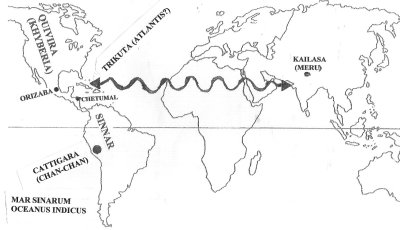 Kristi represented all the archetypical races of mankind before they were changed from pure energy into highly enlightened and spiritual advanced men called Kristis. According to the Ramayana, Kubera, god of wealth, good fortune, gold, agriculture, mining, merchants, etc., decided to rid Northern India of its most undesirable, savage, and incorrigible tribes. The Old Testament mentions Kubera as Heber and his son Peleg. Kubera first took these Meshika (Meshechs) to Lanka, now known as Sri Lanka. Meshika derives from Aramaic, meaning "Messiah." These Meshechs (Meshika or Mexicans?) were no better there than in their old home in Northern India. He then took them to Meso-America or Patala. These became the Olmecs, Mayans, Toltecs, and other tribes. It's no coincidence that so many tribes in both North and South America have names derived from "Meshech." There are the Mochica of Peru, the Nicaraguan Moskitos, in Mexico, the Michoacan and the Meshika; Here in the United States, Mohica, Mohega, Massachusetts, Michigan, Miccosukee, Muskogee, Mascouten, Maskegan, etc. The myths of the Carib Indians made it easy for us to find out the origins of our American Indians and why they were brought here. They told the Spaniards that their mythical forefathers were the Kuru-Rumani (Turks and Hindus). They said that the guards who accompanied the involuntary immigrants to America were Machekael, meaning Meshech Family. In Sanskrit, Kul="kinsman." The mainland Meso-American natives told the Spaniards that North America was Quivira (Khyberia) and that the western coast of South America was Sinnar. In my opinion, that's "telling it like it is." That's a level of accuracy that no modern historian has ever been able to attain. (Ref: El Orígen de los Indios, by Father Gregorio García pp. 318-319.) In those days, the West Indies or Greater Antilles near the coast of eastern Mexico was a huge island called Trikuta. Kubera and his loyal subjects, the Yakshas or Yakhus, built a beautiful city on Trikuta. Later on, about 2,700 to 2,000 B.C., approximately the same time that Abraham and Sarah went to the Middle East from "the other side of the flood," Trikuta sank under the sea, leaving only The West Indies. Could this be the reason why the ancient Mexicans called the idols holding up the rooftops of the temples of Quetzalcoatl, Atlantes? In Nahuatl, Atlan is a toponym meaning "by, on, under the water." Tes or Tech is a locative, meaning "location; in; on; next to, etc." (ref: Llave del Nahuatl (Key to Nahuatl), by Angel MarÌa Garibay.) Tes or Tech may derive from the Sanskrit Deza or Desha, meaning "region; location." Sanskrit Atala means "underworld; Western Hemisphere." The famous Piri Reis map, now on exhibit in the Topkapi museum in Istanbul, Turkey, is said to have been made many thousands of years ago. It shows a huge island off the coast of Veracruz, Mexico, in what are now the West Indies.
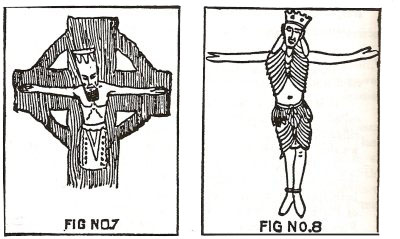 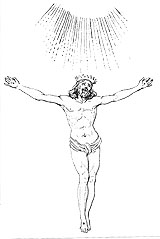 The two pictures at the left are Krishna hanging on his crosses, and the one at the right is Krishna hanging in space, taken from Moor's The Hindu Pantheon (1848). If, as one people with one language for all, this is how they have begun to act, then nothing they propose to do will be out of their reach. Let us, then, go down and confound their speech there, so that they shall not understand one another's speech. Thus the Lord scattered them from there over the face of the whole earth; and they stopped building the city. This is why it was called Babel, because there the Lord confounded the speech of the whole earth; and from there the Lord scattered them over the face of the whole earth. (Genesis 11:6-9.)
According to Hindu teachings, if all humans will sleep at night with their heads facing the east, and their feet pointed toward the west, as well as watching the sun rise at dawn until it reaches about a 25 degree angle every day, the movement of solar energy will tend to harmonize all the races and nations of mankind as one, bringing greater peace, prosperity, and security to the world. This Hindu concept is called The Ramachandra Path of Unity (The Sun-Moon Path of Unity) or The Ramayana Path of Unity. If humans will cooperate in this way, God Bel or Manusa will eventually be transformed into a Kristis, a word meaning "Buddha; teacher; learned man; pandit; enlightened human being." (Ref: The Sanskrit Lexicon.) Plato gave an excellent description of mankind's confinement within and enslavement to the human ego. He compared humans to prisoners who have been imprisoned all their lives inside a dark subterranean cave. A bright light shines through a small hole at the top of the cave. The prisoners, who are chained at the bottom of the cave, see only dark shadows flitting around against the walls. They cave is not sufficiently lighted to let them see the cave clearly. Socrates reasoned that if man would look at and contemplate the shining sun long enough, sooner or later, he would come to conclude that the sun is the cause of all things existing in the visible world, eventually allowing us to know the full meaning of the laws of cause and effect. Ancient Greek philosophers, such as the two I already named, were called Kristos. So-called "rational and scientific-minded" people state that the sun is just a symbol of the inner "light of understanding" that should bring all men to comprehend the secrets of existence. But it is more than a symbol. The unseen radiations from the sun really do energize and strengthen man's mind sufficiently to help him increase his ability to understand and create. According to the teachings of the Ramachandra Path of Unity, if mankind worships only The Second God, Bel, he will need another 25,000 years to achieve spiritual perfection since Noah and his family left the Ark around five thousand years ago. However, if he will sleep in the Sacred Directions, observing the sun from just before sunrise until it rises to about 25 degrees, he will not only enjoy greater health, psychological and emotional well-being, but mankind will become more peaceful and law-abiding. For this reason, if opposing groups feel emotionally calm, they will be more willing to negotiate common differences sanely and rationally. I myself discovered by accident the power of the rising sun to make people feel better physically and emotionally. Older people notice this power more readily because the process of aging has weakened our innate sense of vitality. When some of my elderly friends discovered how the sun was improving me in all areas, they also started watching the sun rise everyday. But why have we not also noticed that the world is improving?
If there is any truth to the Ramachandra Path of Unity, Logos, or Holy Trinity, why do people tend to turn up their noses at the Kristi? Who knows? Your guess is as good as mine. Maybe they're pretending to be "scientific" and "rational." Perhaps we humans are congenital sado-masochists. I'm beginning to suspect that we enjoy the thrill of whirling through space in an eternal combination merry-go-round and roller coaster. Grit your teeth and enjoy the ride!
|

Other religious articles on this site:
.
.
.
.
.
.
.
.
.
.
.
If you have a suggestion or religious article to submit, send it to:
Editor/viewzone.com
myristicin@hotmail.com
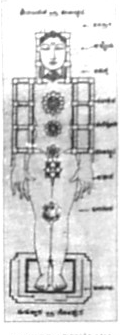 Manusa means "belonging to mankind; human; favorable or propitious to men; the 5 races of man; the condition or manner or action of men, etc." He is represented in Hindu religious iconography as an androgynous human being with his head, shoulders, and arms locked securely within a strange brace or "packing crate" from which he cannot dislodge himself. From his forehead and down the front of his body we see symbols representing "chakras" or mankind's spiritual centers, giving him the potential of becoming a god himself. He is standing on a square showing the extreme limitations of his intelligence, understanding, and perception. In short, Manusa represents a symbolical picture of the human ego. (See the accompanying illustration.)
Manusa means "belonging to mankind; human; favorable or propitious to men; the 5 races of man; the condition or manner or action of men, etc." He is represented in Hindu religious iconography as an androgynous human being with his head, shoulders, and arms locked securely within a strange brace or "packing crate" from which he cannot dislodge himself. From his forehead and down the front of his body we see symbols representing "chakras" or mankind's spiritual centers, giving him the potential of becoming a god himself. He is standing on a square showing the extreme limitations of his intelligence, understanding, and perception. In short, Manusa represents a symbolical picture of the human ego. (See the accompanying illustration.)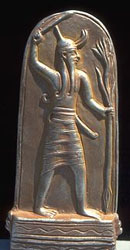 We seem to invoke God Bel unconsciously when our baser passions are aroused, such as hate and violence. A warlike, violent-prone person is called "bellicose." In Spanish, he is bélico. A person rising up against established authority is a "rebel." When a person loses control of himself, becoming temporarily insane, we may say he has gone "ballistic." It seems that any word in which the syllable bal/bel is found implies some undesirable trait, thing, or behavior. For example, a "ball" is at the mercy of ballplayers, vividly described in the ancient Aztec and Mayan ball game of Ulema, symbolizing the "World Egg" floating helplessly in space. A åbull" is either ferocious or meat for dinner. A "balance" or scale implies measuring one thing against another. A "bullet" is a murderous projectile.
We seem to invoke God Bel unconsciously when our baser passions are aroused, such as hate and violence. A warlike, violent-prone person is called "bellicose." In Spanish, he is bélico. A person rising up against established authority is a "rebel." When a person loses control of himself, becoming temporarily insane, we may say he has gone "ballistic." It seems that any word in which the syllable bal/bel is found implies some undesirable trait, thing, or behavior. For example, a "ball" is at the mercy of ballplayers, vividly described in the ancient Aztec and Mayan ball game of Ulema, symbolizing the "World Egg" floating helplessly in space. A åbull" is either ferocious or meat for dinner. A "balance" or scale implies measuring one thing against another. A "bullet" is a murderous projectile.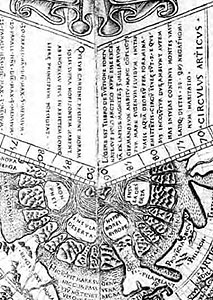 The Greeks called this place "Hyperborea." Among the Turks, it was known as Siberia, translated from Sanskrit as Shivarya (Land of God Shiva). The Tibetan Buddhists call it Khedar Khand (Land of God Shiva) or Shambhala.
The Greeks called this place "Hyperborea." Among the Turks, it was known as Siberia, translated from Sanskrit as Shivarya (Land of God Shiva). The Tibetan Buddhists call it Khedar Khand (Land of God Shiva) or Shambhala. The Aryan Kristaya's religion was named after themselves. The term meant "Way of Life of the Kristaya." They taught that a powerful energy emanating from the sun, called Kristi and Kristaya, moves around the world, constantly and eternally, from east to west, by day and by night, between the Tropics of Cancer and Capricorn. During its eternal circumambulation, it throws out this energy toward the North and South. Even during the night, this unimaginably powerful energy moves like a writhing serpent through the Kristi. It is supposedly strongest from the Hindus' mythical Mt. Meru, thought today to be Mt. Kailasa in Western Tibet, to and through another mountain in Veracruz, Mexico, known today as Citlaltepetl (Mountain of the Moon) a.k.a. Mt. Orizaba. Some Hindus proved this to me by showing how their teachers back in India demonstrated this movement of solar energy from Meru in the Eastern hemisphere to the mountain of Chandra in the Western hemisphere. The teachers folded a polar map, and pushed a pin through the upper west coast of India, penetrating also the West Indian islands off the east coast of Mexico.
The Aryan Kristaya's religion was named after themselves. The term meant "Way of Life of the Kristaya." They taught that a powerful energy emanating from the sun, called Kristi and Kristaya, moves around the world, constantly and eternally, from east to west, by day and by night, between the Tropics of Cancer and Capricorn. During its eternal circumambulation, it throws out this energy toward the North and South. Even during the night, this unimaginably powerful energy moves like a writhing serpent through the Kristi. It is supposedly strongest from the Hindus' mythical Mt. Meru, thought today to be Mt. Kailasa in Western Tibet, to and through another mountain in Veracruz, Mexico, known today as Citlaltepetl (Mountain of the Moon) a.k.a. Mt. Orizaba. Some Hindus proved this to me by showing how their teachers back in India demonstrated this movement of solar energy from Meru in the Eastern hemisphere to the mountain of Chandra in the Western hemisphere. The teachers folded a polar map, and pushed a pin through the upper west coast of India, penetrating also the West Indian islands off the east coast of Mexico.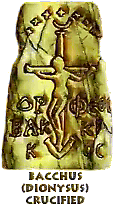 Just as Manu was also known as Bel, so also was Kristi called God Shiva, The First God. According to Hindu mythology, God Shiva knew that humans would need tens of thousands of years to free themselves from the chains and limitations of the human Ego. Therefore, they would need to be pardoned for their sins until they released themselves from their bondage to themselves. So that they would not be destroyed forever, he crucified himself voluntarily the minute he became the incarnate archetypical Only Begotten Son of the Unbegotten Father, who was himself. The images of Shiva show his throat as dark blue from the stain of the deadly poison he swallowed in order to guarantee everlasting life to mankind. Had he not done that, neither the gods nor mortal men would ever have any hope for immortality. He also reincarnated himself physically from time to time, voluntarily allowing himself to be crucified, as further evidence to mankind that he is destined for eternal life. Every nation on earth has stories about crucified Sons of the Sun, but not all of them are called Kristis. Some were called Dionysius, Krishna, Indra, Agni, Mithra, Bacchus, etc. The names are unimportant, for they all represent the same solar energy to which mankind is eternally nailed or tethered. Man's limited understanding, engendered by his imprisonment within the different human languages, has brought about religious provincialism. Yet, regardless of their different names, the so-called "sun gods" are just a personification of the same energy, just as in Spanish, fuego is no different from our English fire. By whatever name, fire burns. Even the bible states that the nations of the world isolated themselves from the others because of their different languages.
Just as Manu was also known as Bel, so also was Kristi called God Shiva, The First God. According to Hindu mythology, God Shiva knew that humans would need tens of thousands of years to free themselves from the chains and limitations of the human Ego. Therefore, they would need to be pardoned for their sins until they released themselves from their bondage to themselves. So that they would not be destroyed forever, he crucified himself voluntarily the minute he became the incarnate archetypical Only Begotten Son of the Unbegotten Father, who was himself. The images of Shiva show his throat as dark blue from the stain of the deadly poison he swallowed in order to guarantee everlasting life to mankind. Had he not done that, neither the gods nor mortal men would ever have any hope for immortality. He also reincarnated himself physically from time to time, voluntarily allowing himself to be crucified, as further evidence to mankind that he is destined for eternal life. Every nation on earth has stories about crucified Sons of the Sun, but not all of them are called Kristis. Some were called Dionysius, Krishna, Indra, Agni, Mithra, Bacchus, etc. The names are unimportant, for they all represent the same solar energy to which mankind is eternally nailed or tethered. Man's limited understanding, engendered by his imprisonment within the different human languages, has brought about religious provincialism. Yet, regardless of their different names, the so-called "sun gods" are just a personification of the same energy, just as in Spanish, fuego is no different from our English fire. By whatever name, fire burns. Even the bible states that the nations of the world isolated themselves from the others because of their different languages.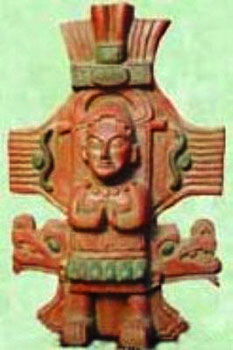 The Aztec Quetzalcoatl and the Mayan Kukulkan, really the same deity, were also crucified. Atheists, "scientists," and skeptics like to boast that they are too "intelligent" and "scientific" to accept the stories of crucified saviors as true. They say that all these stories of crucified sun gods were plagiarisms from a common source. However, the truth is this: These crucified representations pop up in all societies and are not plagiarisms. For those of the Christian faith, this energy belt flowing eternally around the world, between the Tropics of Cancer and Capricorn, is represented archetypically as the vertical beam connected to the horizontal beam to which Christ's body is nailed.
The Aztec Quetzalcoatl and the Mayan Kukulkan, really the same deity, were also crucified. Atheists, "scientists," and skeptics like to boast that they are too "intelligent" and "scientific" to accept the stories of crucified saviors as true. They say that all these stories of crucified sun gods were plagiarisms from a common source. However, the truth is this: These crucified representations pop up in all societies and are not plagiarisms. For those of the Christian faith, this energy belt flowing eternally around the world, between the Tropics of Cancer and Capricorn, is represented archetypically as the vertical beam connected to the horizontal beam to which Christ's body is nailed.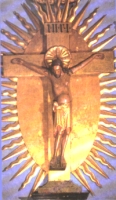 In our Christianity and Hinduism, we are taught that if at least one third of mankind will practice the Ramachandra Path of Unity, which Christians call The Logos (Kristos) or Holy Trinity, the other two-thirds (666) can also be controlled. Logos derives from the Sanskrit Loka, meaning "universe; the space between earth and the sun; Brahma; The Unbegotten. Some Buddhist priests once told me that if just fifteen percent of humans practiced the Ramachandra Path, the remaining eighty five percent could be calmed down. Now, this practice does not mean that the world will become peaceful overnight. Evil and wars may not disappear altogether. However, The Ramayana Path of Unity could reduce personal and collective tensions in the world to a level we can live with. If everybody will align himself with the sun simultaneously as I described, we wouldn't need 25,000 years more of ignorance, tears, and suffering. We could do it in 25 days.
In our Christianity and Hinduism, we are taught that if at least one third of mankind will practice the Ramachandra Path of Unity, which Christians call The Logos (Kristos) or Holy Trinity, the other two-thirds (666) can also be controlled. Logos derives from the Sanskrit Loka, meaning "universe; the space between earth and the sun; Brahma; The Unbegotten. Some Buddhist priests once told me that if just fifteen percent of humans practiced the Ramachandra Path, the remaining eighty five percent could be calmed down. Now, this practice does not mean that the world will become peaceful overnight. Evil and wars may not disappear altogether. However, The Ramayana Path of Unity could reduce personal and collective tensions in the world to a level we can live with. If everybody will align himself with the sun simultaneously as I described, we wouldn't need 25,000 years more of ignorance, tears, and suffering. We could do it in 25 days.